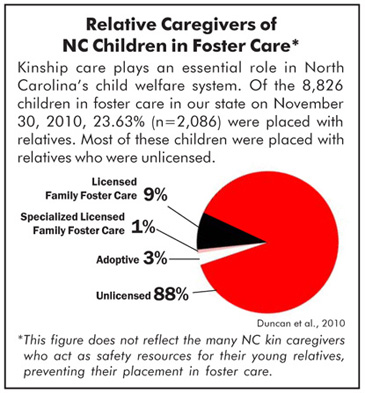To child welfare agencies, extended family members are indispensable partners when it comes to ensuring safety, well-being, and permanence for children.
When they provide temporary care for young relatives, grandparents, aunts, uncles, and other kin often achieve amazing outcomes. Compared to children in nonrelative foster care, children in kinship care:
- Experience fewer placement changes (sources cited in Geen, 2003)
- Are more likely to be placed with siblings (Berrick et al., 1994; Testa & Rolock, 1999)
- Perceive their placements more positively (NSCAW, 2005)
- Have fewer behavioral problems (Conway & Hutson, 2007)
- Visit siblings and parents more often (sources cited in Geen, 2003)
- Have more continuity in family relationships and community ties (US GAO, 1999; LeProhn & Pecora, 1994)
- Are more likely to grow up within the context of their culture and community (Ingram, 1996)
Kinship care is supported not just by the research, but by law. State and federal statues direct child welfare agencies to notify adult maternal and paternal relatives whenever a child enters foster care (P.L. 110-351), and to consider relatives first when placing children (P.L. 104-193).
Given all this, it’s not surprising relative caregivers play a key role in the child welfare system. Today, almost one in four children in the custody of a NC county DSS is cared for by kin (Duncan, et al., 2010).

Support Needs
The results achieved by relative caregivers are all the more amazing when you consider their resources. Although kin caring for child welfare-involved children face the same challenges as nonrelative foster families, they receive less training, fewer services, and less financial support (sources cited in Winokur, et al., 2009).
What’s more, as a group kin caregivers have traits that can make parenting harder: compared to nonrelative caregivers they are more likely to be older, single, less educated, unemployed, and poor. They also report more health problems and higher levels of depression. When assessing and supporting relative placements, child welfare agencies must consider and address needs such as these (sources cited in Winokur, et al., 2009).
Our Responsibility
Child welfare agencies bear a lot of responsibility when it comes to kinship care. To help them, this issue of Practice Notes suggests effective ways to reach out to relatives when children enter foster care and offers ideas for supporting those who provide the invaluable gift of kinship care.
Contents of this Issue